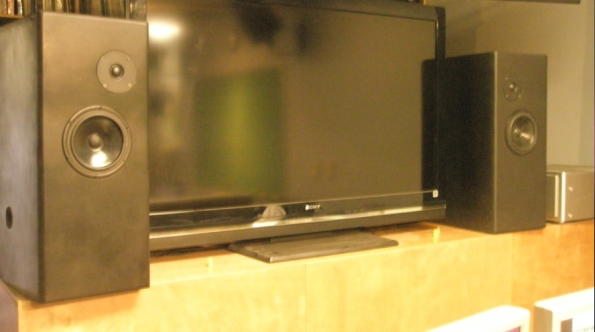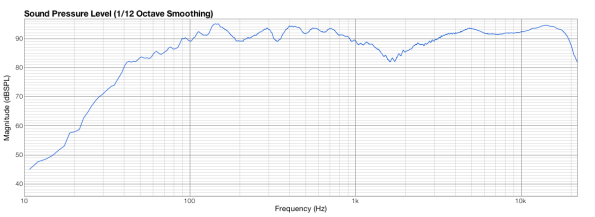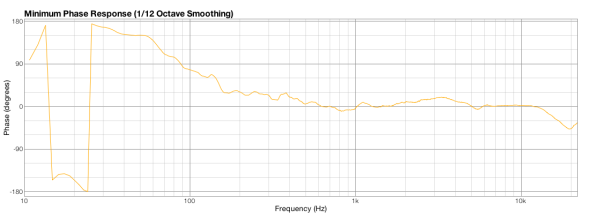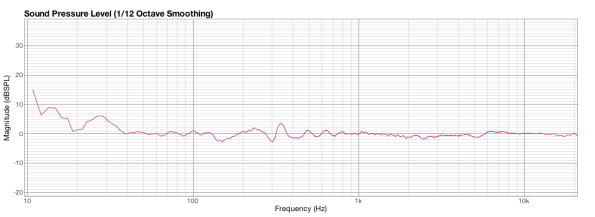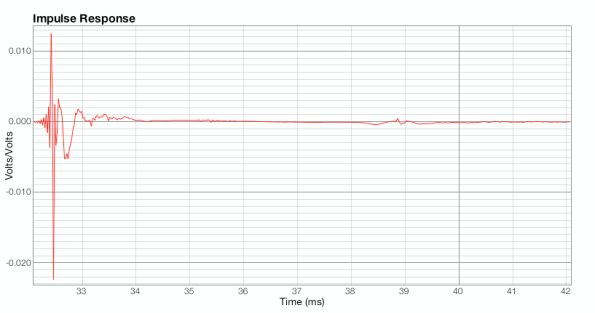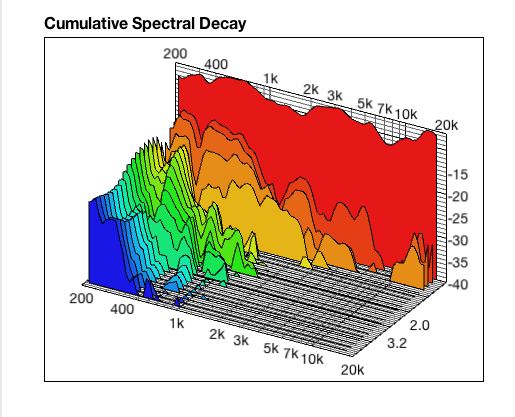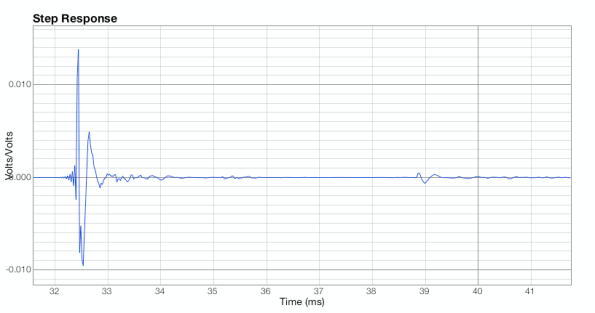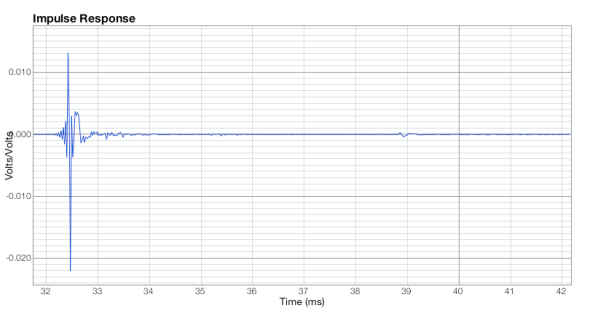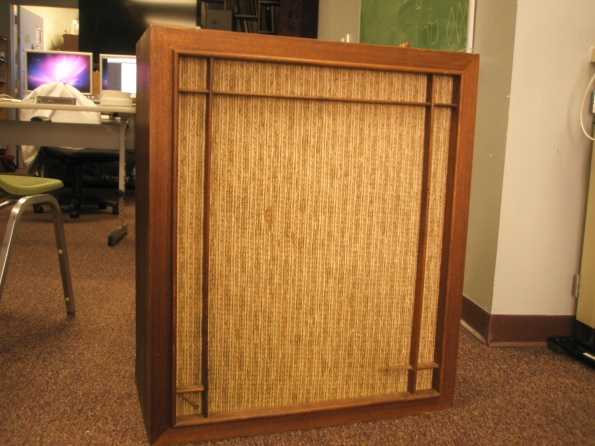K-Series
Overview
This two-way system allows for high quality, high fidelity playback at a considerably low price. With a frequency response that remains within +/- 3 dB, it meets industry standards for applications such as mixing and mastering. The vented enclosure allows extended bass response. With a passive 3rd order crossover at 1.8 kHz, the summation between the 6 1/2″ woofer and 1″ tweeter maintain a flat frequency response.
System Designer:
Spencer Karlovits
Features
- Two-way System
- Vented Enclosure
- Passive Crossover
- Under $500
Drivers
Woofer: Seas Prestige 6 1/2″ CA18RLY
Tweeter: Seas Prestige 1″ 27TDFC
Enclosure
- Interior: 3/4″ 11-ply Birch
- Exterior: 3/4″ MDF

El Palmisté
Overview
The two-way pair of loudspeakers are designed to function as film and music mixing monitors. The design includes an 8″ woofer and a 1″ tweeter mounted against a waveguide to improve its potential. The speakers are vented with a port on each inner side, and have a passive crossover.
Design Goals
- Produce 103 spl to meet film mixing standards (83dB SPL with 20 db of headroom).
- Flat frequency response and maintain detailed sound.
- Good low frequency extension.
- Cost around $500.
- Be somewhat easy to move.
Key Features
- 2-way system
- passive crossover
- vented system
- dome tweeter mounted to waveguide
- f3 of 40hz
- bandwidth of +/- 2.5 dB from 40hz-19khz
Drivers
Scan-Speak Discovery 22W 8″ Woofer
SEAS Prestige 27TDFC 1″ Textile Dome Tweeter
Cabinet
Each wall consists of:
3/4″ ply, 1/8″ loaded vinyl, 3/4″ MDF
Documents


Tests
Frequency Response With Woofer/Tweeter Summation
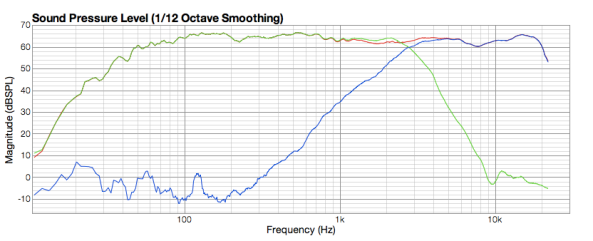
Horizontal Off Axis Response (15,30,45,60)
 Vertical Off Axis (15,30,45,60)
Vertical Off Axis (15,30,45,60)

Frequency Response with Inverted Phase
Impedance as compared to an 8 ohm resister with port and total response
Harmonic Distortion
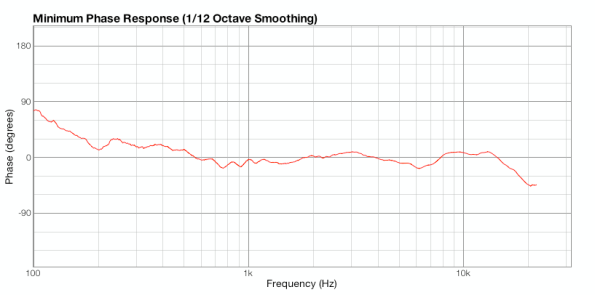 Frequency Response Difference Between Speakers
Frequency Response Difference Between Speakers
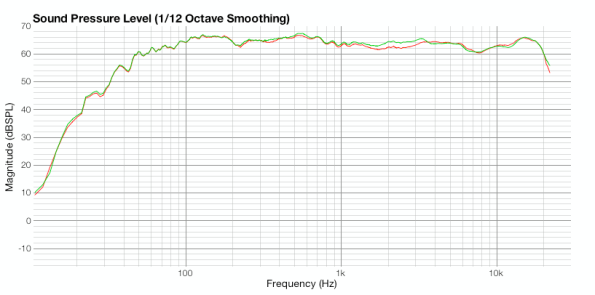 Waterfall Plot in an Anechoic Chamber
Waterfall Plot in an Anechoic Chamber
Woofer
Woofer Response
 Woofer Horizontal Off Axis (15,30,45,60)
Woofer Horizontal Off Axis (15,30,45,60)
 Woofer Vertical Off Axis (15,30,45,60)
Woofer Vertical Off Axis (15,30,45,60)
Woofer Step Response
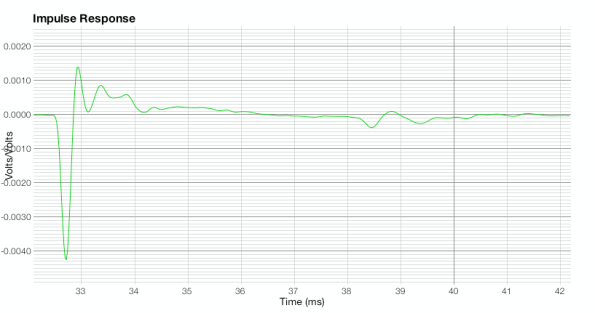 Woofer Harmonic Distortion
Woofer Harmonic Distortion
 Woofer Phase
Woofer Phase
Woofer Response Difference Between Both Speakers
Tweeter Frequency Response
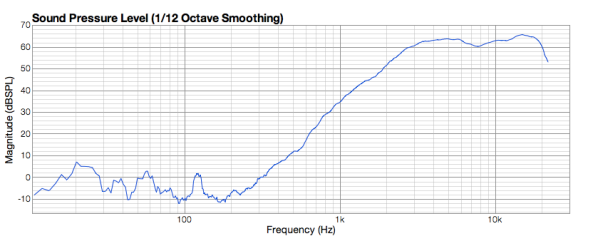 Tweeter Horizontal Off Axis (15,30,45,60)
Tweeter Horizontal Off Axis (15,30,45,60)
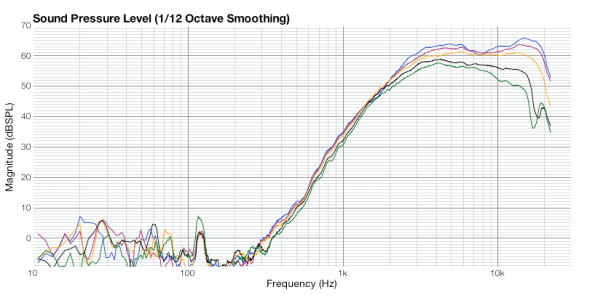 Tweeter Vertical Off Axis (15,30,45,60)
Tweeter Vertical Off Axis (15,30,45,60)
 Tweeter Difference Between Speakers
Tweeter Difference Between Speakers

El Palmisté by Alex Palma is licensed under a Creative Commons Attribution-NonCommercial 3.0 Unported License.
Weathered Mannes’
Overview:
The Weathered Mannes’ are a pair of 2-way portable speakers. They were designed to provide an accurate casual listening experience as well as the ability to accurately mix. They feature a passive crossover system and vented enclosures. The f3 of these speakers is 38Hz with the extension the port provides. They were built with an interior layer of 3/4″ MDF and an exterior layer of 3/4″ Birch.
Drivers:
Peerless PPB 830874 Poly Cone Woofer
SEAS 27TDFC Textile Dome Tweeter
Documents:
Final Testing Report Contains All Final Test Images
Wharfdale W90 project
Wharfdale W90 project
This project was intended to refurbish a set of Wharfdale W90 “six” way speakers. These speakers were old, had poor frequency extension, a lot of distortion, and a frequency response curve that looked as if a pice of spaghetti had been thrown at the spl chart. Despite this there was some unique concepts that went in to the design of these speakers originally and to be honist studying the designs of this old set of hi-fi speakers was more educational that building the speakers themselves. These speakers featured a rear baffle that was filled with sand in between two layers of wood this clever dampening design if implemented more fully though out the cabinet design process could be a useful tool in making enclosures that are both ridged and dampened. The 12 inch woofers had a unique design as well. Each cab used two woofers in a separate enclosure. This was done for the purpose of tuning one of the enclosures differently. To achieve this Wharfdale filled one of the cones with Styrofoam, this changed the moving mass of the piston (the cone of the driver) it also decreased the surface area. I suspect that this was done to even out the low end frequency response by filling in gaps that the normal woofer had ether in the low end or the high end of its range. these speakers also had a strange mid range and tweeter design. The tweeter and mid range drivers were not placed in a sealed enclosure as most cone mid range drivers and tweeters are rather they were placed in an open box(see pics below). this open box design created a lot of positive and negative summation due to the reflections off of the rear baffle and the sides and tops of the box. these reflections were severely detrimental to the frequency response and over all clarity. After the speakers had been finished I ran in to the same problem; how ever it was nearly as dramatic as in the original design. Due to the fact that cloth dome tweeters and mid range drivers were selected only the reflections off of the sides of the boxes that caused summation issues. I plan to experiment with this later to see how much moving the front baffle forward improves the frequency response. There is no doubt in my mind that the amplitude of summation is directly related to the depth of the open box. Over all the goal of improving the quality of these speakers was accomplished; the frequency response was improved and the F3 was increased to about 70 Hz from an original extension of about 100 Hz. However the comb filtering effect caused by the cab design makes these speakers sound boxy and dated. In the end these vintage Hi-Fi cabs retained a vintage tone but with greater detail and frequency extension while having flatter frequency response.
Initial Testing
 Original Frequency Response At 0 Degrees and 3 Feet.
Original Frequency Response At 0 Degrees and 3 Feet.
 The Tweeter and The Mid They Could Not Be Tested Alone
The Tweeter and The Mid They Could Not Be Tested Alone
Testing
the full system at 0, 15, 30, 45, and 60 degrees offset
Left right comparison
 Vertical off axis at 0, 15, 30, 45, and 60 degrees
Vertical off axis at 0, 15, 30, 45, and 60 degrees
 Ful system Harmonic distortion percentage
Ful system Harmonic distortion percentage
Full system Waterfall
 Tweeter offset at 0, 15, 30, 45, 60 degrees
Tweeter offset at 0, 15, 30, 45, 60 degrees
 Tweeter Vertical At 0, 15, 30, 45, and 60 Degrees
Tweeter Vertical At 0, 15, 30, 45, and 60 Degrees
Tweeter Total Harmonic Distortion
 Mid At 0, 15, 30, 45, 60 degrees offset
Mid At 0, 15, 30, 45, 60 degrees offset
 Mid Vertical Off Axis Response
Mid Vertical Off Axis Response
 Woofer At 0, 15, 30, 45, ND 60 Degrees offset
Woofer At 0, 15, 30, 45, ND 60 Degrees offset
 Woofer Verticle Offset At 0, 15, 30, 45, and 60 Degrees
Woofer Verticle Offset At 0, 15, 30, 45, and 60 Degrees
FrankenSound by Justin Boldenow
General Overview:
I was drawn to the openness and clarity of electrostatic drivers and a dipole system. I chose to build the large coffin-like subwoofer enclosures so that the 15” drivers would be capable of reaching mid-range frequencies and the lowest ends of human hearing. The coffin look is both interesting and functional as unusual shaped enclosures diffract frequencies and help disperse stored energy.
Design Goals:
My first and foremost desire was for monitors that had enough bandwidth, clarity and accuracy to be used as mixing monitors. The electrostatic drivers came with clarity and accuracy so I wanted to design enclosures that could match this and supply the rest of the frequency range needed. I wanted to cover the range of human hearing from high to low accurately.
Design objectives:
• Even full-range frequency response
• Low harmonic distortion
• Dipole system
• Completely original design
Key Features:
• 2-way crossover with potential of 3-way
• Passive crossover with potential of adding an active crossover
• dipole sub/mid woofer enclosure for extended low frequency response and “air”
• Electrostatic tweeters
• Coffin shaped design
• Chalkboard paint
Technical Specifications:
• Bandwidth 25 Hz-20kHz, +- 4 dB
• Max SPL 85 dB with 20 dB headroom
• f3 30 Hz
• f10 16 kHz
Cabinet Construction:
My cabinets are made out of 3/4 inch 13 ply baltic birch plywood and 3/4 inch MDF, this was done to keep the structure solid. Plywood was chosen because of its construction with alternating grain. The MDF’s density helps deaden the cabinet.
The Subwoofer cabinets were designed to be large so as to achieve lower end frequencies. The larger the box was, due to its dipole characteristics, the more resonance it had at lower frequencies. This was done to achieve low frequencies with just a 15in driver instead of using larger drivers and sacrificing mid-frequencies. The coffin design is an irregular shape which helps to disperse stagnant energy held within cabinets. It also fits my personality.
Tweeter:
I chose the Final Sound electrostatic speakers and built the rest of my system to fit it. I chose these drivers because they covered high frequencies and high midrange, which would save me costs in midrange drivers. I also chose these drivers because of their dipole nature and incredible transient qualities. Though the driver wasn’t the flattest in response I believe this can be cured with acoustic tuning of the room that they are placed in. Unfortunately, a standard crossover would not work on these because their impedence nature had a completely different curve in testing. They were left with the natural crossover that they were manufactured with.
Subwoofer:
For the subwoofer I went with the only infinite baffle designed drivers I could find. The Dayton IB’s were specifically engineered for dipole use and their sound is incredible. Unfortunately the drivers themselves were designed to reach 40 Hz which didn’t fit my requirements. This is why I built such large boxes and gained another 15 Hz lower.
Cross-over:
As I stated before, a standard crossover would not function on the electrostatic drivers and were left to function with their natural manufactured crossover. This implies that I only needed to build a crossover for one driver and the crossover was the simplest crossover to create. I used a 1st order Butterworth at 100 Hz. I chose this frequency because it was roughly where the electrostatic ended and where the subwoofer began to slope downward slightly. Though the total frequency response of the system looks a little rough, I plan to correct a lot of it with acoustically treating its environment and experimenting with black-hole fiberglass/foam.
Testing:
Overall Speaker Performance:
Frequency Response
Harmonic distortion
Step Response
Off Axis Response
Frequency response with individual drivers overlayed
Green is the overall response, Yellow is the subwoofer and Red is the tweeter
Tweeter Performance:
Frequency Response
Subwoofer Performance:
Frequency Response
Monitor 1 by Keith Kinnear
High Performance Studio Monitors
The main objective of this design was simply to create the most accurate, high precision studio monitors possible. The speakers were able to meet that objective in almost every way thanks to some key components of the design.
One of the most influential aspects is the cabinet construction, including the unique six-sided shape and complicated panel and joint structures. They help these speakers avoid a whole host of problems traditional box designs usually have to deal with. Panel vibrations, internal cabinet standing wave resonances, and most of the effects of edge diffraction did not pose a problem with these speakers in the least.
An equally important element of the design was the choice of high quality transducers – and believe me, no expense was spared when it came to choosing the right drivers to fit the design criteria. Both the tweeters and woofers are low distortion, high bandwidth drivers that are known for their smooth, un-colored sound. Both of them are also great performers and made it easy to implement them into this, and likely almost any other, design.
The crossover is the last piece of the puzzle to be mentioned since it connects everything together and literally shapes the sound of the signal being presented to the drivers. Many hours of testing and very careful manipulation of the passive circuit elements produced a crossover that reacts with the drivers in such a way that the on-axis frequency response only varies by 2 dB across a spectrum from 50 Hz to 18 kHz. Now that’s something that anyone can be proud of.
In all, the design was a success and the speakers have proven to do exactly what they were designed for – be highly accurate, high performance studio monitors.

Monitor 1 by Keith Kinnear is licensed under a Creative Commons Attribution-Noncommercial-Share Alike 3.0 United States License.
 Design Objectives
Design Objectives
- Highly accurate studio monitors for precision mixing and mastering
- Relatively low crossover point to preserve vocal presence range
- At least 103 dB SPL max output
- f3 = 45Hz
Key Features
- Full range two-way design made possible by the use of wide bandwidth, low distortion drivers
- Unique cabinet shape and construction designed to eliminate many of the common diffraction, vibration, and resonance problems found in traditional box designs
- Exceptionally flat frequency response from 50Hz to 18 kHz
- Excellent impulse and step (time domain) responses, indicating a lack of time smearing and greatly improved clarity and transient accuracy
- Outstanding horizontal off-axis response
- Sturdy handles on the sides to make movement possible
System Tests
Tweeter Tests – Scanspeak D3004/6600-00 AirCirc
Woofer Tests – Seas L22RN4X/P H1208
Odyssey Speaker System by Brad Korstange

My speakers
General Overview:
I wanted to build a pair of tower speakers that would work well will my home theater system that i am in the process of making. I chose tower speakers because with a tower speaker you don’t have to find or make speaker stands and they end up at about the right height while sitting on a normal couch.
Overall Speaker Performance:

Please note the scale, y axis only goes to 10

Not entirely sure what this graph shows but it is required

looks fairly flat to me

Blue is on axis, Green is 15 degrees off axis, Red is 30 degrees off axis, and Maroon is 456 degrees off axis

Blue is the subwoofer filter, Red is the midrange filter, and Green is the tweeter filter

Maroon is the overall response, Green is the subwoofer, Red is the midrange and Yellow is the tweeter

Tweeter

I'm impressed

Looks a bit weird to me

It works for me

- Red is on axis, Green is 15 degrees off axis, Blue is 30 degrees off axis, and Yellow is 45 degrees off axis

Yep looks kind of bad in the 300 to 500 Hz range

not to bad

nice shape

pretty flat

- Yellow is on axis, Blue is 15 degrees off axis, Green is 30 degrees off axis, and Red is 45 degrees off axis

I can't really remember what color is what but as you can see not much happens as you move off axis

keep in mind that the sub cross over is at around 100 Hz so everything above that is kind of useless data

for the frequency range it is used it looks pretty good

Odyssey Speaker System by Brad Korstange is licensed under a Creative Commons Attribution-Noncommercial-Share Alike 3.0 United States License.
Alters to Ibormeith and Latis
High Quality Home Listening Speakers by Bryan Thorne
Design Concept
These speakers were designed to be “high-fi” style home listening speakers for my personal enjoyment. They are intended to provide a rich, detailed listening experience and a wide stereo image for hours of auditory refinement in my bedroom.
Nomenclature
Caer Ibormeith and Latis were Celtic Goddesses prior to the spread of Catholicism. Latis was the Goddess of water and beer. Caer Ibormeith was the Goddess of sleep, dreams, and music. I hope to spend many nights listening to these speakers whilst trapped in the pages of a good book and drifting in and out of my personal reveries accompanied by my favorite archaic beverage.
Drivers
Fountek NeoCD3.0 3″ Ribbon Tweeter: Chosen for it’s clarity and low distortion. Ribbon tweeters are capable of providing a very accurate and detailed stereo image. Many previous Transducer Theory students have used them with great success.
Peerless 850518 6.5″ Woofer: This driver was chosen to operate as the midrange woofer in this system. Peerless drivers are known for their clarity and smooth response. This driver also extends high enough in the frequency band to make for an easy crossover point at 1.5kHz with the tweeter. As luck would have it I was able to attain this driver for free.
Peerless 850146 10″ Subwoofer: This subwoofer also bears the Peerless name which came so highly recommended to me by former transducer theory students. With this driver in a vented box I was able to achieve a strong bass response down to 40Hz.
Enlosure
The box for these speakers was constructed of 11-ply Birch Plywood. This provided a strong structure and the crossing layers of wood eliminate box resonances. 11-ply was chosen over 13-ply Baltic Birch because of the significantly reduced production costs. A single layer of the wood was used for the construction to maintain a reasonable weight. The box was constructed with a 3.5 cubic foot enclosure for the subwoofer with a 3 inch port for a Qtc of 0.54. The box had a separate sealed enclosure for the midrange driver with a Qtc of 0.7. The internal walls of the sealed box also doubled as bracing for the larger box.
Crossover
The crossover design for this speaker system evolved into a rather large circuit, but in the end it resulted in an admirable frequency response and a very pleasant sound, so it is well worth it. The subwoofer has a simple 2nd order low-pass filter on it set around 100Hz. The midrange driver has a 2nd order high-pass set around 100Hz and a 2nd order low-pass at 1.5kHz. The midrange also has an L-Pad circuit to bring it inline with the subwoofer made of a 1.5Ohm resistor in line, and a 6.5Ohm resistor in parallel to ground. A baffle step correction circuit was also added to the midrange. The tweeter benefits from a 3rd order high-pass filter set slightly higher at 2.5k. Shifting this point up made for a smoother crossover point and protects the delicate ribbon tweeter from more of the low frequencies. The tweeter also received an L-Pad circuit to bring it down to the same level as the other drivers.
Measurements

This work is licensed under a Creative Commons Attribution-Noncommercial-Share Alike 3.0 United States License.
Introducing the 2-WMT BY: DJ Puuri
2-WMT Design Objetives
- Under $800
- 2-way studio monitor for critical listening
- Largest of bandwidth as possible
- Low Harmonic Distortion
Key Design Features
- Eton 25 SD1 textile dome tweeter
- Tang Band W6 1721 6.5″ Underhung Midbass Drivers
- Low crossover point of 1500Hz allowing for exceptional clarity in vocal consonant range
- Vented tower design allowing for extended low frequency performance
- Durable red mahogany/matte black finish
Technical Specs
- Frequency Coverage 55Hz-14K +/- 4dB
- Max SPL 83dB SPL with 20dB Headroom
- f3=55Hz f10=20,000Hz
Description
The 2-WMT is a 2-way studio monitor tower. The design of the 2-WMT makes it ideal for critical listening at an affordable price. A vented tower design allows for extended low frequency coverage.
Overall Design Goal
The objective of this project was to design and construct a 2-way speaker system. This system would serve as a studio monitor. In order to adequately serve as a studio monitor this system should provide the listener with a few key features.
1. A bandwidth coverage of as close to (20Hz-20K) as possible
2. The frequency response should be as flat as possible across bandwidth
3. Low harmonic distortion
Key Technology
Cabinet Construction
The cabinet for the 2-WMT is a combination of 3/4” 11ply birch plywood and 3/4” MDF. This combination was instituted for two specific purposes. The plywood had proven beneficial acoustically in past designs. The MDF would allow for the distinct look the finished cabinet displays. The cabinet features a triple layer front baffle. The outer two layers are MDF while the inner layer is 11ply Birch. This was done with the intention of having an interior of all 11ply birch. The rear of the enclosure is double layers. The inner most layer once again is 11ply birch. The outer baffle and rear of cabinet are MDF this allows for the sleek matte black finish. The rear of the cabinet is also designed so that it can be removed. This allows for access to all system components. To battle resonance inner bracing was installed every 16” from the bottom of the cabinet connecting to each side panel. This allows for the use of a single layer on each side.
Diffraction issues where accounted for in the cabinet design. The front baffle includes a 3/8” round over on both edges. While both the tweeter and woofer are flush mounted to the baffle.
Being as the woofer features a underhung design the inner two layers of the baffle have been carefully treated. They have been rounded over inside the woofer mounting hole. This insures full linear excursion of the woofer. With sound waves being free to move off the rear of the cone. The cabinet features a durable red mahogany finish on sides and top with the baffle, base, and rear being matte black.
Driver Characteristics
The Eton 25 SD1 tweeter was chosen for its smooth frequency response and low frequency extension. This would allow for a crossover point of 1500Hz. My max SPL requirement of 83 dB SPL at one meter is accomplished with this tweeter.
The Tang Band W6 1721 6.5″ woofer was chosen for a number of reasons. These features all allow for low frequency extension. This woofer has a linear excursion of 8mm, this is almost double that of most 6.5″ woofers. The narrow design of the cabinet along with the triple layer baffle made using the W6 wise. It features a underhung motor design. This would allow it to operate smoothly in a relatively compact space.
Cross-over
A cross over point of 1500Hz was established so that it would be bellow the vocal consonant range. (2K-5K) In order to make the two drivers work together in this system, The tweeter was roll off with a 1st order butterworth at 1500Hz with a 8dB pad on it. The woofer was rolled off at 1000Hz with a 3rd order butterworth. A 10dB baffle step circuit was design and implemented at 1140 Hz. This was placed prior the low pass circuit on the woofer. The woofer exhibited a bit of a bump from 500Hz to 1200K. The baffle step circuit smoothed this out nicely. The overall crossover design allows for a +/- 4dB difference from 55Hz to 14K. With all parts being purchased for just over $100.
Other
A port tuning of 60Hz with a 2″ wide and 4″ long port was established thru use of a port tuning calculator. This was adjusted during testing to around 50HZ. The final port was 2″ wide by 6″ long. This allows the frequencies down to 20Hz to be present. This system along with some acoustic treatment allows for a very full bandwidth. Which is quite incredible given the use of single 6.5″ woofer in each cabinet.

2-WMT by Duane(DJ) Puuri is licensed under a Creative Commons Attribution 3.0 United States License.
Based on a work at dipuuri.wordpress.com.
Permissions beyond the scope of this license may be available at http://dipuuri.wordpress.com/wp-admin/post-new.php?post_type=page.
Design Documents
- Design Proposal
- Drafting
- Testing Report
- System Tests
Full System Frequency Response Full System Harmonic Distortion
Full System Harmonic Distortion Full System Step Response
Full System Step Response Full System Phase Response
Full System Phase Response Full System Off Axis Response (Purple to Green=0,15,30,45 degrees)
Full System Off Axis Response (Purple to Green=0,15,30,45 degrees) Full System Cross Over Response
Full System Cross Over Response Woofer and Tweeter Frequency Response With Summation
Woofer and Tweeter Frequency Response With Summation Tweeter Performance
Tweeter Performance
Tweeter Frequency Response
 Tweeter Harmonic Distortion
Tweeter Harmonic Distortion
 Tweeter Step Response
Tweeter Step Response
 Tweeter Minimum Phase Response
Tweeter Minimum Phase Response
 Tweeter Off Axis Response (Purple to Green=0,15,30,45 degrees)
Tweeter Off Axis Response (Purple to Green=0,15,30,45 degrees)

Woofer Performance
Woofer Frequency Response
 Woofer Harmonic Distortion
Woofer Harmonic Distortion
 Woofer Step Response
Woofer Step Response
 Woofer Minimum Phase Response
Woofer Minimum Phase Response
 Woofer Off Axis Response (Purple to Green=0,15,30,45 degrees)
Woofer Off Axis Response (Purple to Green=0,15,30,45 degrees)

Other Tests Of Interest
Impedance

Left Right Difference

Port Tuning (Blue calculated port 2"D 4"L, Green port installed 2"D 6"L)

